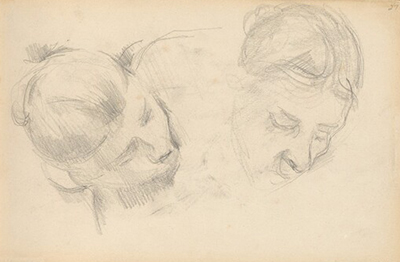 Buy Art Prints Now
Buy Art Prints Nowfrom Amazon
* As an Amazon Associate, and partner with Google Adsense and Ezoic, I earn from qualifying purchases.
This double portrait features two unrelated artworks together for the purpose of studying portraiture. Cezanne tackles a female face from two different angles and places them together on the same sheet of woven paper.
Portraiture has always been a genre that requires large amounts of practice in order to be mastered and Paul Cezanne entirely understood that. He would use sketchbooks to practice elements of his paintings, just as Turner had done centuries earlier for British landscape paintings. Cezanne tended to feature both full length studies that focused on body shape as well as close up facial work as found here. He also captured his wife in many artworks, and it may well be her featured here. Indeed, there are other portraits of her within the sketchbook in which this artwork was discovered and so it seems the most plausible explanation. She is drawn from two different angles, although perhaps the artist merely rotated the book slightly, rather than asking the model to actually alter her own pose.
The artist here would leave his detail in light tones, clearly using his graphite without too much strength in his fingers. He wanted to leave something charming and not add too much focus on any one part of the drawing. He used slightly thicker strokes to create a suggestion of shadow, but even that is completed in a relatively subtle manner. Both faces have fairly serious expressions, with eyes relatively closed, deliberately in order to help the artist to perfect certain parts of the face. He pays good attention to the hair in both cases, and avoids including anything below the neckline. The eyebrows and nose are also well formed, though nothing such as wrinkles are included here. It would have been a fairly quick expression of work, particularly considering the by now he would have been very comfortable in portraits such as this, having done so many already.
The seventy-odd drawings within this sketchbook can be found at the National Gallery of Art in the US and is one of the few from his career that remains still as he left it. Most others were broken up, with the artworks inside then sold off separately. The institution itself continues to go from strength-to-strength, with frequent further acquisitions as well as a number of high profile donations from friends of this establishment. Some of the other notable artists to be found within their collection include Rubens, van Ruysdael, Hopper, Durer and Bierstadt, who together represent the impressive breadth of movements and periods found at this large venue which continues to attract huge numbers of visitors every year.



